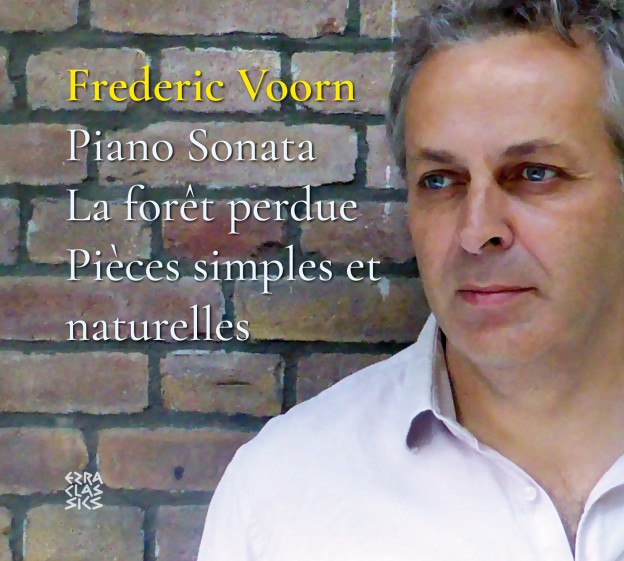This CD appeared at the end of 2016 and is dedicated to Frederic Voorn’s own piano compositions. These pieces, performed by himself, were written between 2005 and 2016.
The CD can be purchaced in EU countries for € 17,– (international postage included). If you send this amount with your name and address to IBAN nr. NL50INGB0000188367, (swift code = Bic INGBNL2A) attention to F.T.C.G. Voorn, we will mail you the CD as soon as possible. If you are in a non-euro country, you can pay by paypal. Please send us a mail for further details.
reviews
…”This music is timeless and sounds immediately familiar.”… (Platomania)
“…Voorn’s music is tonal, with sparkling en beautiful melodies. It is also technically interesting and performed by the composer himself with great passion and empathy. Contemporary and tonal music go well together, provided that there is an abundance of musical ideas. And in these compositions that is certainly the case. Voorn’s early Pièces simples et naturelles (2005) and his suite La forêt perdue (2015) are lyric tone paintings, with a whiff of nostalgia, French joie de vivre and much attention to tone colour. The recently completed Piano Sonata (2016) reminds us of late Prokofiev, but without his preference for sharp dissonances. Voorn uses his salt and pepper sparingly and the Sonata gets it’s rich spiciness from a mix of restrained sarcasm and the masterly use of polyfony and the octatonic scale.”… (Olga de Kort in Muze Pianowereld)
…”Voorn’s fascinating Piano Sonata, with its majestic, late romantic and sometimes fierce singularity relates well to Prokofiev in his most amiable mood. Lyricism, nostalgia and playfullness determine the alternately slow and fast ’tone impressions’ of La forêt perdue, while Voorn in his Pièces simples et naturelles connects with French composers like Satie and Tiersen, and sometimes even adds a whiff of Spain.”… (Wenneke Savenije in Klassieke Zaken)
…”The Pièces simples et naturelles, composed in 2005, are exactly what the title promises: wonderful relaxing pieces that create the atmosphere of a lazy Summer evening, somewhere in the Méditerranée. And do we not all yearn for that?”… (Website VPRO Vrije Geluiden)
Play list
Piano Sonata (2016)
1 Allegro ma non troppo 6 ‘ 05
2 Andante 6 ‘ 34
3 Vivace 4 ‘ 21
La forêt perdue. Suite pour piano (2015)
4 La naissance du jour 4 ‘ 28
5 La chasse 4 ‘ 02
6 Petite danse du temps perdu 2 ‘ 50
7 Jeux d’hirondelles 3 ‘ 20
8 Claire de nuit 3 ‘ 39
Pièces simples et naturelles (2005)
9 Nantua 3 ‘ 23
10 Sarabande 2 ‘ 52
11 Intermezzo 2 ‘ 08
12 Lament 4 ‘ 05
13 Nos enfants, Berceuse 3 ‘ 44
Frederic Voorn piano
EZRA CLASSICS EC 150665
Liner notes
After playing music by other composers on four previous CD’s, this is the first one dedicated exclusively to my own piano music. The works heard here were written between 2005 and 2016, but many motives, themes and inspirations came from earlier date. For me this is not uncommon: the first theme of the last movement of my String Quartet from 2006 was already written when I was 18 years old and in the first year of the conservatory. I did not want to study composition at the time, the early eighties, because there was very little room left for composers – let alone composition students – who didn’t want to have to go through the obligatory study of atonal and serial composition techniques. In those days, these were about the only acceptable musical styles for a contemporary composer, although not accepted by a large section of the audience. Fortunately today- also for that audience – we are less fundamentalistic and are willing to embrace the great diversity of musical styles. Each bird sings as it is beaked.
The Pièces simples et naturelles were written in the Summer of 2005. Nantua is a French village, somewhere between Lyon and Geneva, that has a beautiful postcard-like lake. The Sarabande was already recorded in 2012 for my CD Music Box and belongs to my most popular works.
The Suite La forêt perdue has taken many years to write and was completed in 2015. La chasse, the second movement of the suite, was already conceived in 2009. The fourth movement, Jeux d’hirondelles, is inspired by swallows in Italy, who every late afternoon, with spectacular dives over the water, would feed themselves with floating insects.
The Piano Sonata was written in 2016 and has clear Russian influences. The opening motives of the first and last movements are based on an octatonic scale, already used by Debussy, Stravinsky and Messiaen, where whole and half notes are playes alternately. In the middle movement, a marche funèbre brings the work with a grotesque dance to the climax of the sonata.
